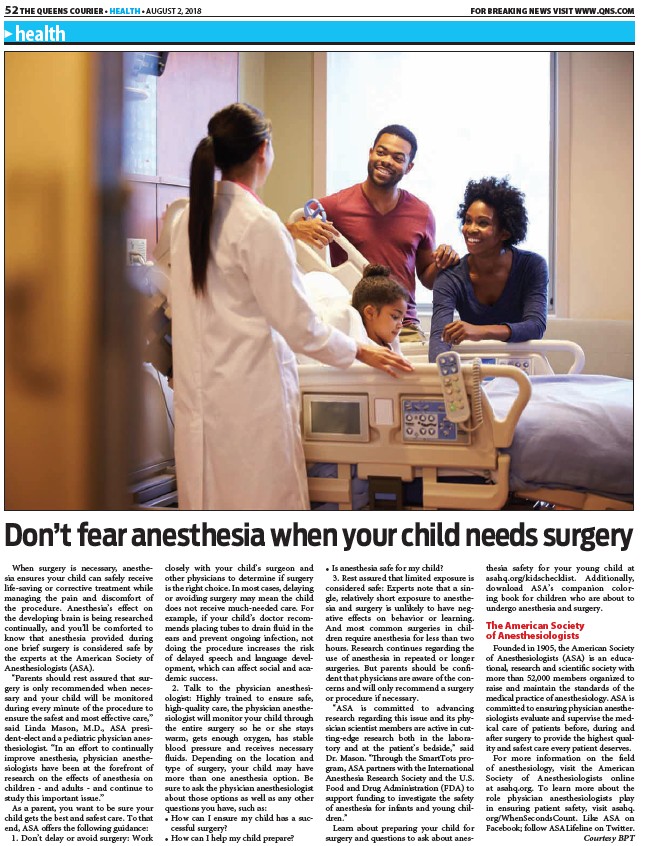
52 THE QUEENS COURIER • HEALTH • AUGUST 2, 2018 FOR BREAKING NEWS VISIT WWW.QNS.COM
health
Don’t fear anesthesia when your child needs surgery
When surgery is necessary, anesthesia
ensures your child can safely receive
life-saving or corrective treatment while
managing the pain and discomfort of
the procedure. Anesthesia’s eff ect on
the developing brain is being researched
continually, and you’ll be comforted to
know that anesthesia provided during
one brief surgery is considered safe by
the experts at the American Society of
Anesthesiologists (ASA).
“Parents should rest assured that surgery
is only recommended when necessary
and your child will be monitored
during every minute of the procedure to
ensure the safest and most eff ective care,”
said Linda Mason, M.D., ASA president
elect and a pediatric physician anesthesiologist.
“In an eff ort to continually
improve anesthesia, physician anesthesiologists
have been at the forefront of
research on the eff ects of anesthesia on
children - and adults - and continue to
study this important issue.”
As a parent, you want to be sure your
child gets the best and safest care. To that
end, ASA off ers the following guidance:
1. Don’t delay or avoid surgery: Work
closely with your child’s surgeon and
other physicians to determine if surgery
is the right choice. In most cases, delaying
or avoiding surgery may mean the child
does not receive much-needed care. For
example, if your child’s doctor recommends
placing tubes to drain fl uid in the
ears and prevent ongoing infection, not
doing the procedure increases the risk
of delayed speech and language development,
which can aff ect social and academic
success.
2. Talk to the physician anesthesiologist:
Highly trained to ensure safe,
high-quality care, the physician anesthesiologist
will monitor your child through
the entire surgery so he or she stays
warm, gets enough oxygen, has stable
blood pressure and receives necessary
fl uids. Depending on the location and
type of surgery, your child may have
more than one anesthesia option. Be
sure to ask the physician anesthesiologist
about those options as well as any other
questions you have, such as:
• How can I ensure my child has a successful
surgery?
• How can I help my child prepare?
• Is anesthesia safe for my child?
3. Rest assured that limited exposure is
considered safe: Experts note that a single,
relatively short exposure to anesthesia
and surgery is unlikely to have negative
eff ects on behavior or learning.
And most common surgeries in children
require anesthesia for less than two
hours. Research continues regarding the
use of anesthesia in repeated or longer
surgeries. But parents should be confi -
dent that physicians are aware of the concerns
and will only recommend a surgery
or procedure if necessary.
“ASA is committed to advancing
research regarding this issue and its physician
scientist members are active in cutting
edge research both in the laboratory
and at the patient’s bedside,” said
Dr. Mason. “Th rough the SmartTots program,
ASA partners with the International
Anesthesia Research Society and the U.S.
Food and Drug Administration (FDA) to
support funding to investigate the safety
of anesthesia for infants and young children.”
Learn about preparing your child for
surgery and questions to ask about anesthesia
safety for your young child at
asahq.org/kidschecklist. Additionally,
download ASA’s companion coloring
book for children who are about to
undergo anesthesia and surgery.
The American Society
of Anesthesiologists
Founded in 1905, the American Society
of Anesthesiologists (ASA) is an educational,
research and scientifi c society with
more than 52,000 members organized to
raise and maintain the standards of the
medical practice of anesthesiology. ASA is
committed to ensuring physician anesthesiologists
evaluate and supervise the medical
care of patients before, during and
aft er surgery to provide the highest quality
and safest care every patient deserves.
For more information on the fi eld
of anesthesiology, visit the American
Society of Anesthesiologists online
at asahq.org. To learn more about the
role physician anesthesiologists play
in ensuring patient safety, visit asahq.
org/WhenSecondsCount. Like ASA on
Facebook; follow ASALifeline on Twitter.
Courtesy BPT